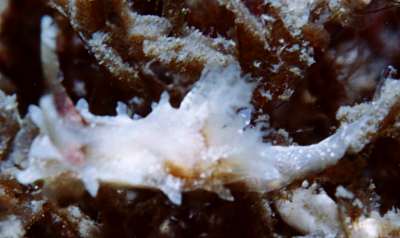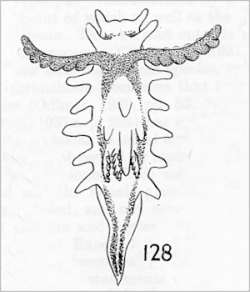

Okenia evelinae
Marcus, 1957
Order: NUDIBRANCHIA
Suborder: DORIDINA
Superfamily: ANADORIDOIDEA
Family: Goniodorididae
DISTRIBUTION
West Atlantic - Brazil, Florida
PHOTO
Upper: Live animal from Lake Worth Lagoon, Florida, USA. Depth: 15 feet. January 2004. Approx 3/8 inch. Photo: Judy Townsend.
Lower: Okenia evelinae. Marcus, 1957 - Fig 128.
Okenia evelinae is known only from the original description from Brazil, the description being based on 23 specimens, the largest being 8mm long alive. They were found on the arborescent bryozoan Amathia convoluta, and the colour was described as:
".. integument white and contains refractive granules on the back. The tissues of the inner organs are yellow, the liver dark yellow. The dorsal appendages, the gills and the borders of the foot are pure white. The rhinphores are violet, and the same colour occurs on the sides, the tail, and in small quantities on the back of full grown animals."
Marcus also described 4 dorsal papillae in front of the gills, 2 median and 2 lateral, and a series of 5 or 6 "blunt peg-shaped appendages on each side" along the mantle edge. Although the dorsal papillae are not clear in Judy Townsend's photo, the other features of the external shape and colour, as described by Marcus, are. In this photo, the purple markings on the body, as described by Marcus, are replaced by a brownish colour, but as the purple on the rhinophores merges into brown, this is obviously a variable character in this species.
Clark (1984) considers O. evelinae to be a synonym of O. zoobotryon and this approach has been followed by later authors. As I discuss in a separate message, I disagree with that decision.
Characters distinguishing the two species include O. zoobotryon feeding on Zoobotryon [many records] while O. evelinae apparently feeds on Amathia sp. [1 report]. In colour O. zoobotryon is essentially translucent with small brown spots, while O. evelinae is translucent white with opaque white spots, and has purple rhinophores [or purplish brown] and a symmetrical pattern of the same colour on the body. The mantle papillae in O. zoobotryon have a narrow stalk and a rounded terminal bulb while those of O. evelinae are short and triangular in shape.
References:
• Clark, K. B. (1984) New records and synonymies of Bermuda opisthobranchs (Gastropoda). The Nautilus, 98(2): 85-97.
• Edmunds, M. & Just, H. (1985) Dorid, dendronotoid and arminid nudibranchiate Mollusca from Barbados. Journal of molluscan Studies, 51(1): 52-63.
• Marcus, Er. (1957) On Opisthobranchia from Brazil (2). Journal of the Linnean Society of London, Zoology, 43(292): 390-486.
• Redfern. C., (2001) Bahamian Seashells: a Thousand Species from Abaco, Bahamas. Bahamianseashells.com Inc: Boca Raton. 1-280.
• Smallwood, W.M. (1910). Notes on the Hydroids and Nudibranchs of Bermuda. Proc. Zool. Soc. London. 1: 137-145
• Smallwood, W. M. (1913) Polycerella zoobotryon (Smallwood). Proceedings of the American Academy of Arts & Sciences, 47(16): 609-630.
• Valdes, A. & Ortea, J. (1995) Revised taxonomy of some species of the genus Okenia Menke, 1830 (Mollusca: Nudibranchia) from the Atlantic Ocean, with the description of a new species. The Veliger, 38(3): 223-234.
Rudman, W.B., 2004 (January 28) Okenia evelinae Marcus, 1957. [In] Sea Slug Forum. Australian Museum, Sydney. Available from http://www.seaslugforum.net/factsheet/okenevel
Related messages
-
Bryozoan of Okenia evelinae
From: Linda Ianniello, February 11, 2004 -
Food of Okenia evelinae
From: Bill Rudman, February 5, 2004 -
Okenia evelinae f rom Florida
From: Linda Ianniello, January 28, 2004 -
Rediscovery of Okenia evelinae
From: Bill Rudman, January 28, 2004
